Corporate Accounting and Reporting: Goodwill Impairment Reversal
VerifiedAdded on 2021/05/30
|10
|1575
|31
Report
AI Summary
This report delves into the intricacies of corporate accounting and reporting, with a specific focus on the reversal of impairment loss of goodwill. The analysis begins by outlining the core principles of accounting, emphasizing the importance of accurate asset valuation in financial reports. It explains the concept of impairment loss and its reversal, detailing scenarios where previously impaired assets regain value. The report references key accounting standards, particularly AASB 136, and clarifies the treatment of goodwill impairment and its non-reversal in specific situations. The discussion includes the assessment of goodwill impairment on a yearly basis, the role of cash-generating units, and the methods for determining recoverable amounts. The conclusion reiterates the conditions under which impairment loss reversal is possible and highlights the importance of accurate projections and asset amortization. The report emphasizes that goodwill impairment loss generally cannot be reversed under AASB 136.
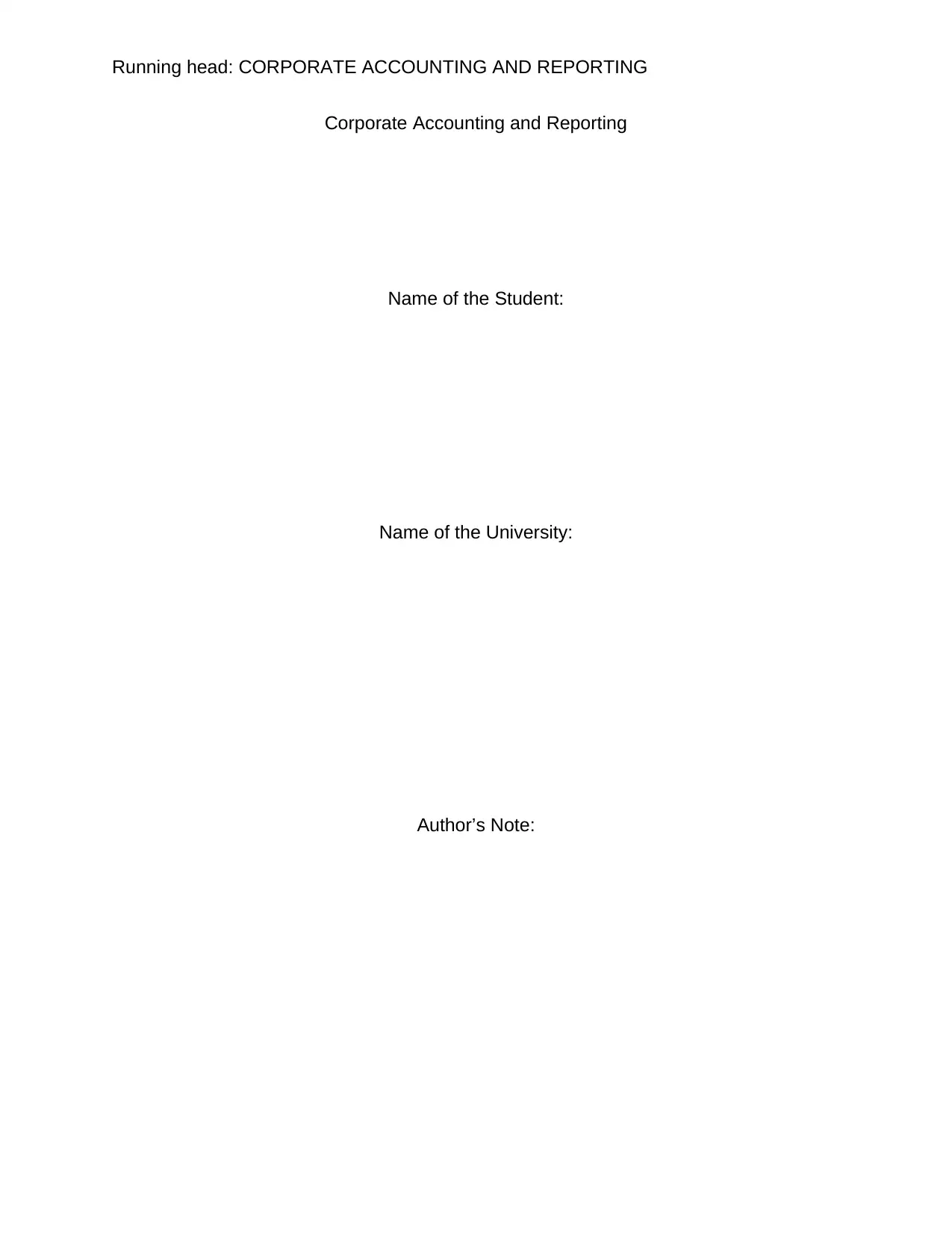
Running head: CORPORATE ACCOUNTING AND REPORTING
Corporate Accounting and Reporting
Name of the Student:
Name of the University:
Author’s Note:
Corporate Accounting and Reporting
Name of the Student:
Name of the University:
Author’s Note:
Paraphrase This Document
Need a fresh take? Get an instant paraphrase of this document with our AI Paraphraser
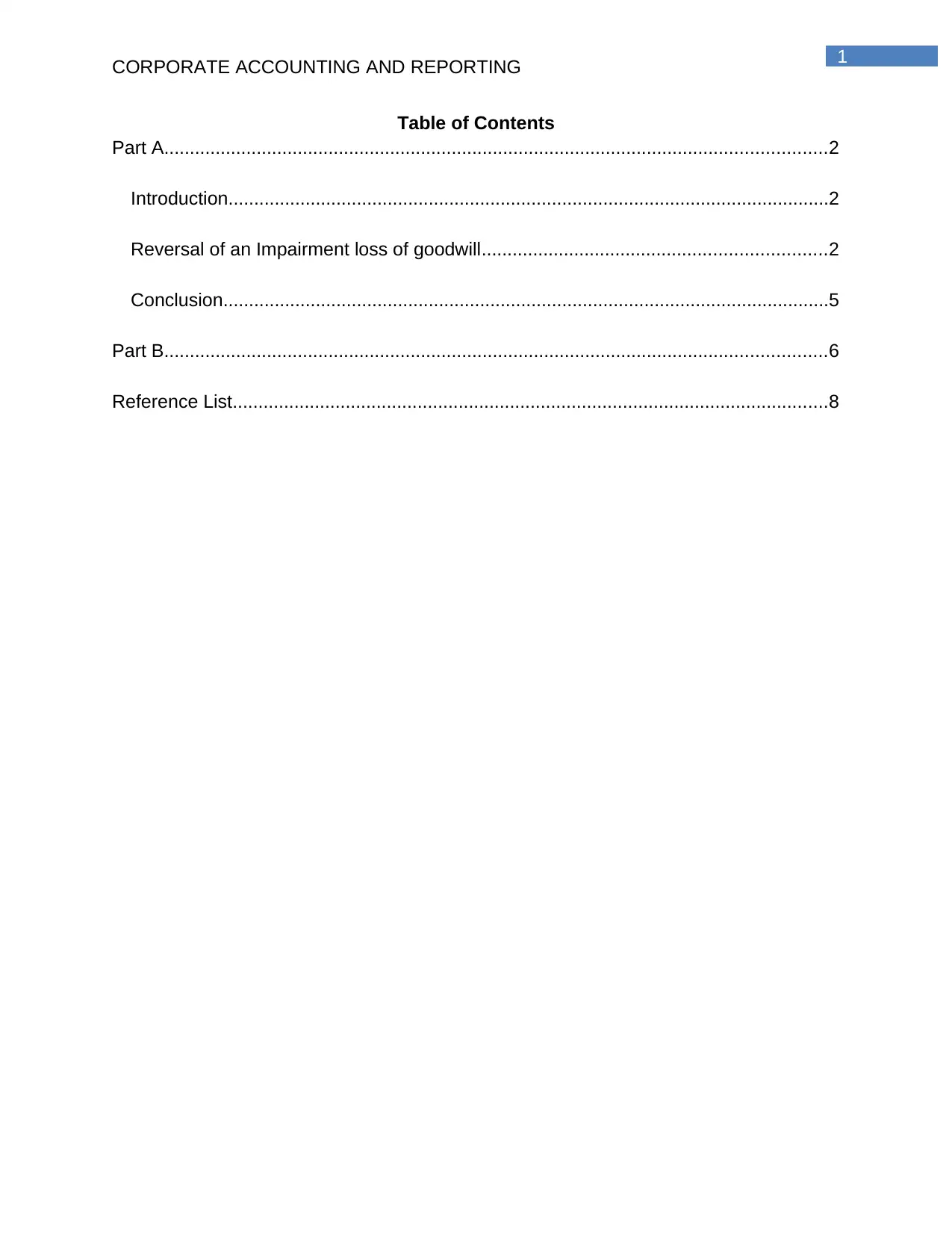
1
CORPORATE ACCOUNTING AND REPORTING
Table of Contents
Part A.................................................................................................................................2
Introduction.....................................................................................................................2
Reversal of an Impairment loss of goodwill...................................................................2
Conclusion......................................................................................................................5
Part B.................................................................................................................................6
Reference List....................................................................................................................8
CORPORATE ACCOUNTING AND REPORTING
Table of Contents
Part A.................................................................................................................................2
Introduction.....................................................................................................................2
Reversal of an Impairment loss of goodwill...................................................................2
Conclusion......................................................................................................................5
Part B.................................................................................................................................6
Reference List....................................................................................................................8
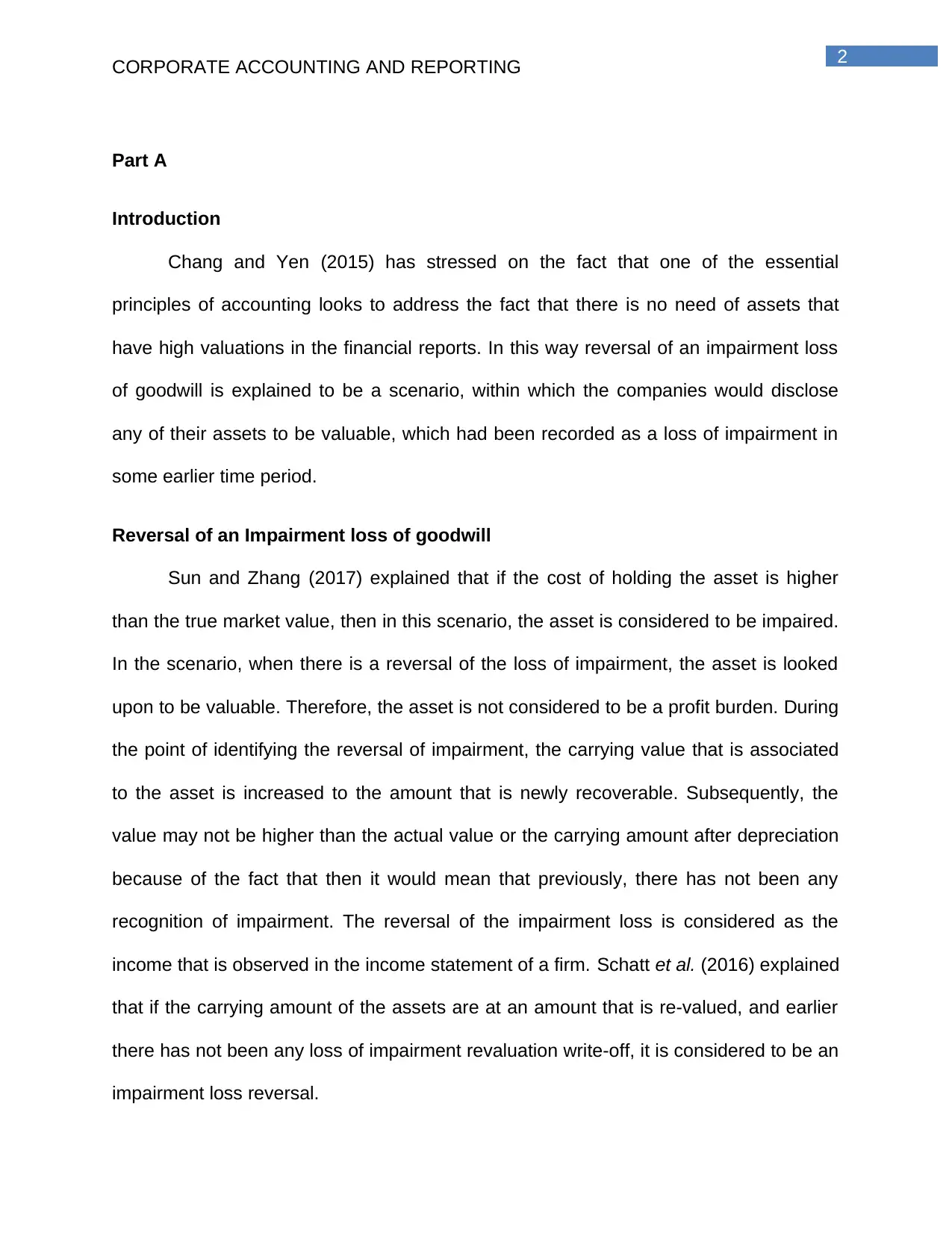
2
CORPORATE ACCOUNTING AND REPORTING
Part A
Introduction
Chang and Yen (2015) has stressed on the fact that one of the essential
principles of accounting looks to address the fact that there is no need of assets that
have high valuations in the financial reports. In this way reversal of an impairment loss
of goodwill is explained to be a scenario, within which the companies would disclose
any of their assets to be valuable, which had been recorded as a loss of impairment in
some earlier time period.
Reversal of an Impairment loss of goodwill
Sun and Zhang (2017) explained that if the cost of holding the asset is higher
than the true market value, then in this scenario, the asset is considered to be impaired.
In the scenario, when there is a reversal of the loss of impairment, the asset is looked
upon to be valuable. Therefore, the asset is not considered to be a profit burden. During
the point of identifying the reversal of impairment, the carrying value that is associated
to the asset is increased to the amount that is newly recoverable. Subsequently, the
value may not be higher than the actual value or the carrying amount after depreciation
because of the fact that then it would mean that previously, there has not been any
recognition of impairment. The reversal of the impairment loss is considered as the
income that is observed in the income statement of a firm. Schatt et al. (2016) explained
that if the carrying amount of the assets are at an amount that is re-valued, and earlier
there has not been any loss of impairment revaluation write-off, it is considered to be an
impairment loss reversal.
CORPORATE ACCOUNTING AND REPORTING
Part A
Introduction
Chang and Yen (2015) has stressed on the fact that one of the essential
principles of accounting looks to address the fact that there is no need of assets that
have high valuations in the financial reports. In this way reversal of an impairment loss
of goodwill is explained to be a scenario, within which the companies would disclose
any of their assets to be valuable, which had been recorded as a loss of impairment in
some earlier time period.
Reversal of an Impairment loss of goodwill
Sun and Zhang (2017) explained that if the cost of holding the asset is higher
than the true market value, then in this scenario, the asset is considered to be impaired.
In the scenario, when there is a reversal of the loss of impairment, the asset is looked
upon to be valuable. Therefore, the asset is not considered to be a profit burden. During
the point of identifying the reversal of impairment, the carrying value that is associated
to the asset is increased to the amount that is newly recoverable. Subsequently, the
value may not be higher than the actual value or the carrying amount after depreciation
because of the fact that then it would mean that previously, there has not been any
recognition of impairment. The reversal of the impairment loss is considered as the
income that is observed in the income statement of a firm. Schatt et al. (2016) explained
that if the carrying amount of the assets are at an amount that is re-valued, and earlier
there has not been any loss of impairment revaluation write-off, it is considered to be an
impairment loss reversal.
⊘ This is a preview!⊘
Do you want full access?
Subscribe today to unlock all pages.

Trusted by 1+ million students worldwide
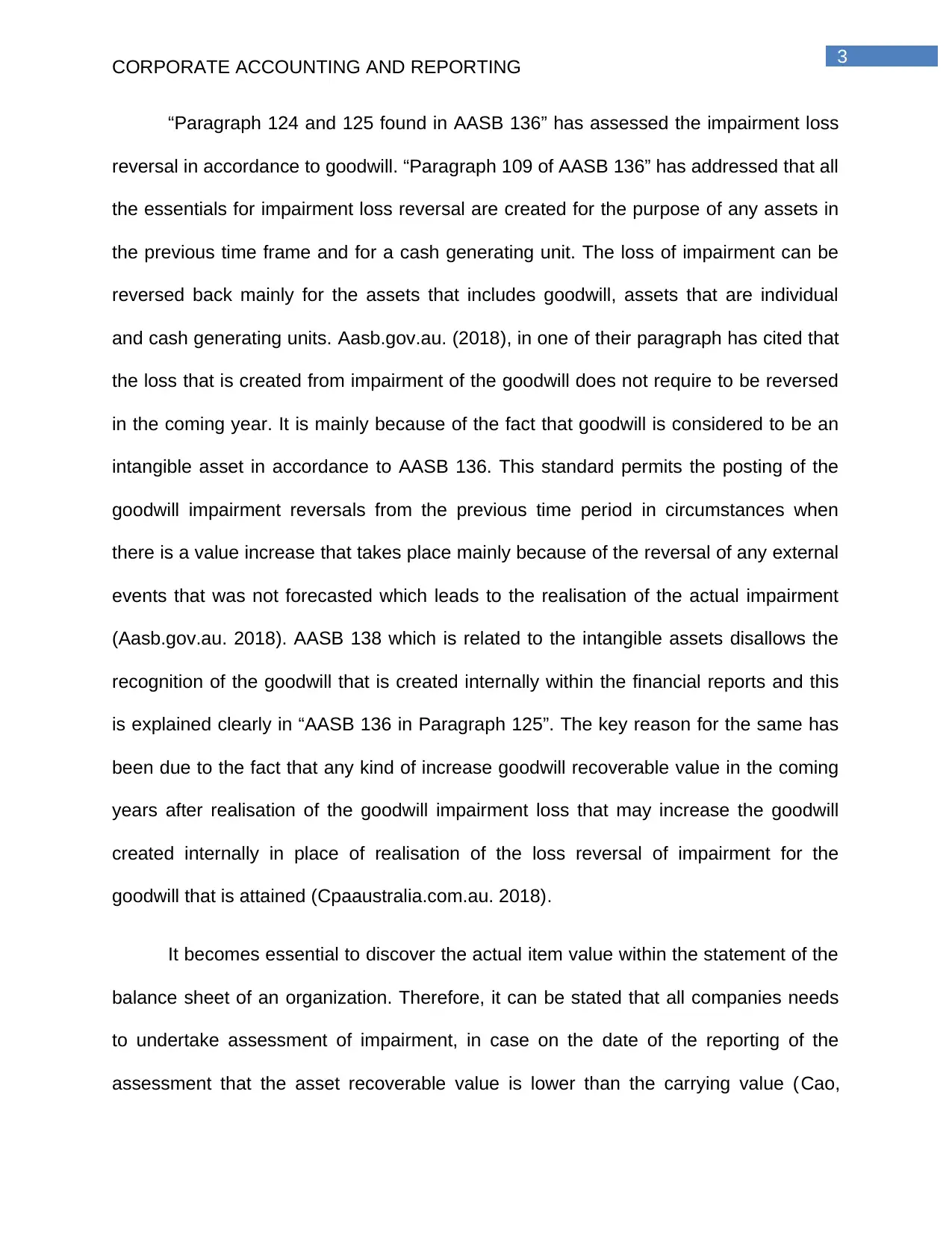
3
CORPORATE ACCOUNTING AND REPORTING
“Paragraph 124 and 125 found in AASB 136” has assessed the impairment loss
reversal in accordance to goodwill. “Paragraph 109 of AASB 136” has addressed that all
the essentials for impairment loss reversal are created for the purpose of any assets in
the previous time frame and for a cash generating unit. The loss of impairment can be
reversed back mainly for the assets that includes goodwill, assets that are individual
and cash generating units. Aasb.gov.au. (2018), in one of their paragraph has cited that
the loss that is created from impairment of the goodwill does not require to be reversed
in the coming year. It is mainly because of the fact that goodwill is considered to be an
intangible asset in accordance to AASB 136. This standard permits the posting of the
goodwill impairment reversals from the previous time period in circumstances when
there is a value increase that takes place mainly because of the reversal of any external
events that was not forecasted which leads to the realisation of the actual impairment
(Aasb.gov.au. 2018). AASB 138 which is related to the intangible assets disallows the
recognition of the goodwill that is created internally within the financial reports and this
is explained clearly in “AASB 136 in Paragraph 125”. The key reason for the same has
been due to the fact that any kind of increase goodwill recoverable value in the coming
years after realisation of the goodwill impairment loss that may increase the goodwill
created internally in place of realisation of the loss reversal of impairment for the
goodwill that is attained (Cpaaustralia.com.au. 2018).
It becomes essential to discover the actual item value within the statement of the
balance sheet of an organization. Therefore, it can be stated that all companies needs
to undertake assessment of impairment, in case on the date of the reporting of the
assessment that the asset recoverable value is lower than the carrying value (Cao,
CORPORATE ACCOUNTING AND REPORTING
“Paragraph 124 and 125 found in AASB 136” has assessed the impairment loss
reversal in accordance to goodwill. “Paragraph 109 of AASB 136” has addressed that all
the essentials for impairment loss reversal are created for the purpose of any assets in
the previous time frame and for a cash generating unit. The loss of impairment can be
reversed back mainly for the assets that includes goodwill, assets that are individual
and cash generating units. Aasb.gov.au. (2018), in one of their paragraph has cited that
the loss that is created from impairment of the goodwill does not require to be reversed
in the coming year. It is mainly because of the fact that goodwill is considered to be an
intangible asset in accordance to AASB 136. This standard permits the posting of the
goodwill impairment reversals from the previous time period in circumstances when
there is a value increase that takes place mainly because of the reversal of any external
events that was not forecasted which leads to the realisation of the actual impairment
(Aasb.gov.au. 2018). AASB 138 which is related to the intangible assets disallows the
recognition of the goodwill that is created internally within the financial reports and this
is explained clearly in “AASB 136 in Paragraph 125”. The key reason for the same has
been due to the fact that any kind of increase goodwill recoverable value in the coming
years after realisation of the goodwill impairment loss that may increase the goodwill
created internally in place of realisation of the loss reversal of impairment for the
goodwill that is attained (Cpaaustralia.com.au. 2018).
It becomes essential to discover the actual item value within the statement of the
balance sheet of an organization. Therefore, it can be stated that all companies needs
to undertake assessment of impairment, in case on the date of the reporting of the
assessment that the asset recoverable value is lower than the carrying value (Cao,
Paraphrase This Document
Need a fresh take? Get an instant paraphrase of this document with our AI Paraphraser
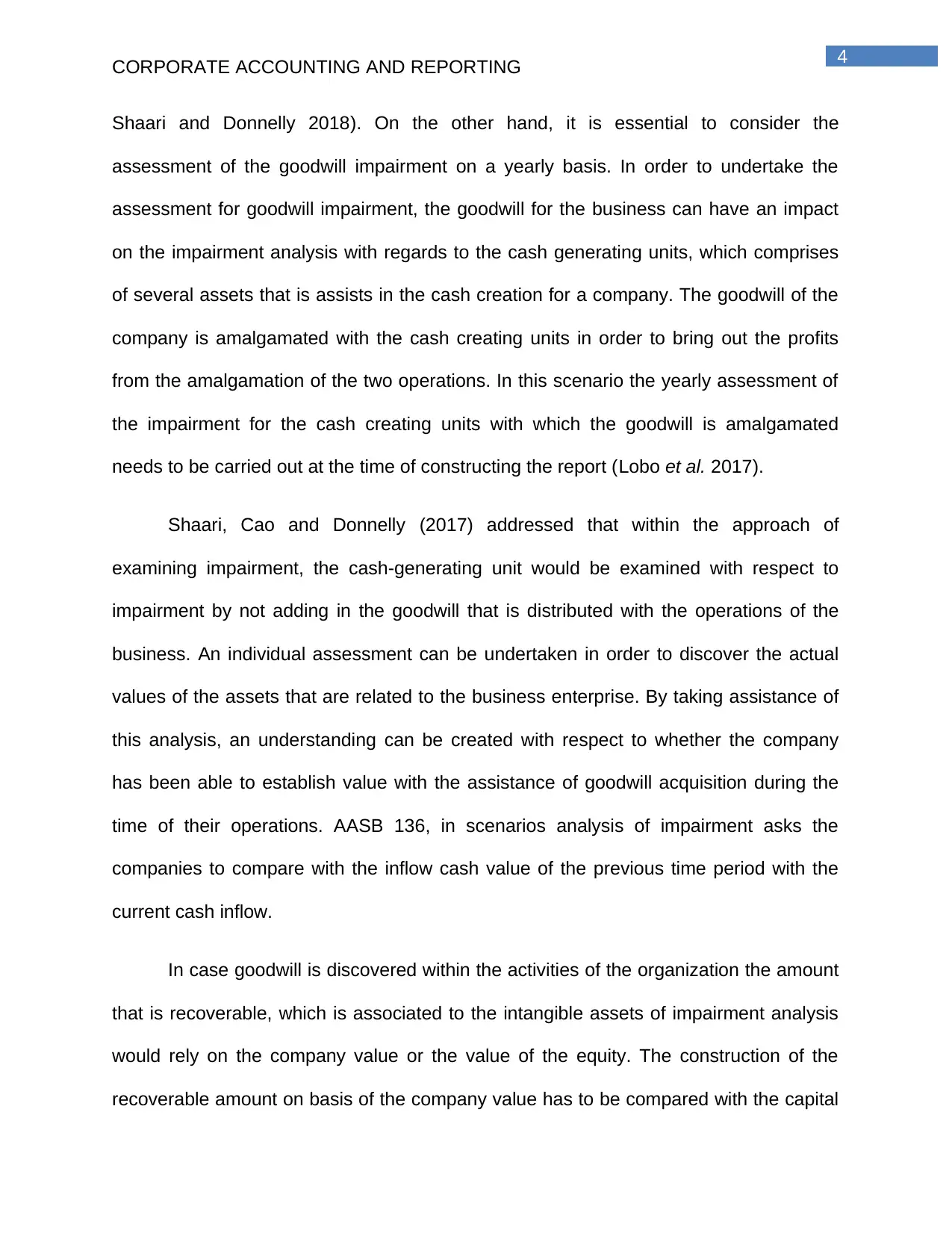
4
CORPORATE ACCOUNTING AND REPORTING
Shaari and Donnelly 2018). On the other hand, it is essential to consider the
assessment of the goodwill impairment on a yearly basis. In order to undertake the
assessment for goodwill impairment, the goodwill for the business can have an impact
on the impairment analysis with regards to the cash generating units, which comprises
of several assets that is assists in the cash creation for a company. The goodwill of the
company is amalgamated with the cash creating units in order to bring out the profits
from the amalgamation of the two operations. In this scenario the yearly assessment of
the impairment for the cash creating units with which the goodwill is amalgamated
needs to be carried out at the time of constructing the report (Lobo et al. 2017).
Shaari, Cao and Donnelly (2017) addressed that within the approach of
examining impairment, the cash-generating unit would be examined with respect to
impairment by not adding in the goodwill that is distributed with the operations of the
business. An individual assessment can be undertaken in order to discover the actual
values of the assets that are related to the business enterprise. By taking assistance of
this analysis, an understanding can be created with respect to whether the company
has been able to establish value with the assistance of goodwill acquisition during the
time of their operations. AASB 136, in scenarios analysis of impairment asks the
companies to compare with the inflow cash value of the previous time period with the
current cash inflow.
In case goodwill is discovered within the activities of the organization the amount
that is recoverable, which is associated to the intangible assets of impairment analysis
would rely on the company value or the value of the equity. The construction of the
recoverable amount on basis of the company value has to be compared with the capital
CORPORATE ACCOUNTING AND REPORTING
Shaari and Donnelly 2018). On the other hand, it is essential to consider the
assessment of the goodwill impairment on a yearly basis. In order to undertake the
assessment for goodwill impairment, the goodwill for the business can have an impact
on the impairment analysis with regards to the cash generating units, which comprises
of several assets that is assists in the cash creation for a company. The goodwill of the
company is amalgamated with the cash creating units in order to bring out the profits
from the amalgamation of the two operations. In this scenario the yearly assessment of
the impairment for the cash creating units with which the goodwill is amalgamated
needs to be carried out at the time of constructing the report (Lobo et al. 2017).
Shaari, Cao and Donnelly (2017) addressed that within the approach of
examining impairment, the cash-generating unit would be examined with respect to
impairment by not adding in the goodwill that is distributed with the operations of the
business. An individual assessment can be undertaken in order to discover the actual
values of the assets that are related to the business enterprise. By taking assistance of
this analysis, an understanding can be created with respect to whether the company
has been able to establish value with the assistance of goodwill acquisition during the
time of their operations. AASB 136, in scenarios analysis of impairment asks the
companies to compare with the inflow cash value of the previous time period with the
current cash inflow.
In case goodwill is discovered within the activities of the organization the amount
that is recoverable, which is associated to the intangible assets of impairment analysis
would rely on the company value or the value of the equity. The construction of the
recoverable amount on basis of the company value has to be compared with the capital
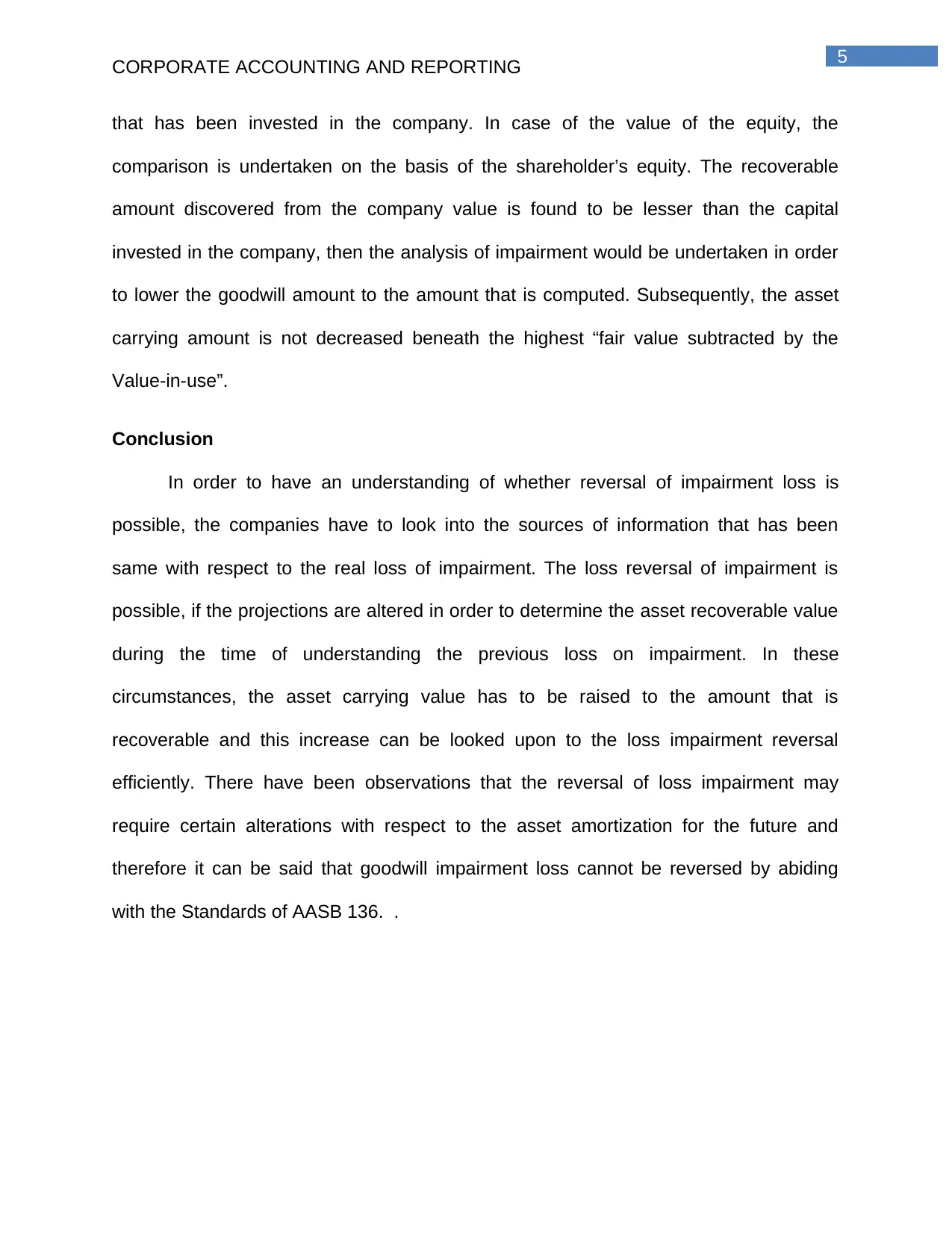
5
CORPORATE ACCOUNTING AND REPORTING
that has been invested in the company. In case of the value of the equity, the
comparison is undertaken on the basis of the shareholder’s equity. The recoverable
amount discovered from the company value is found to be lesser than the capital
invested in the company, then the analysis of impairment would be undertaken in order
to lower the goodwill amount to the amount that is computed. Subsequently, the asset
carrying amount is not decreased beneath the highest “fair value subtracted by the
Value-in-use”.
Conclusion
In order to have an understanding of whether reversal of impairment loss is
possible, the companies have to look into the sources of information that has been
same with respect to the real loss of impairment. The loss reversal of impairment is
possible, if the projections are altered in order to determine the asset recoverable value
during the time of understanding the previous loss on impairment. In these
circumstances, the asset carrying value has to be raised to the amount that is
recoverable and this increase can be looked upon to the loss impairment reversal
efficiently. There have been observations that the reversal of loss impairment may
require certain alterations with respect to the asset amortization for the future and
therefore it can be said that goodwill impairment loss cannot be reversed by abiding
with the Standards of AASB 136. .
CORPORATE ACCOUNTING AND REPORTING
that has been invested in the company. In case of the value of the equity, the
comparison is undertaken on the basis of the shareholder’s equity. The recoverable
amount discovered from the company value is found to be lesser than the capital
invested in the company, then the analysis of impairment would be undertaken in order
to lower the goodwill amount to the amount that is computed. Subsequently, the asset
carrying amount is not decreased beneath the highest “fair value subtracted by the
Value-in-use”.
Conclusion
In order to have an understanding of whether reversal of impairment loss is
possible, the companies have to look into the sources of information that has been
same with respect to the real loss of impairment. The loss reversal of impairment is
possible, if the projections are altered in order to determine the asset recoverable value
during the time of understanding the previous loss on impairment. In these
circumstances, the asset carrying value has to be raised to the amount that is
recoverable and this increase can be looked upon to the loss impairment reversal
efficiently. There have been observations that the reversal of loss impairment may
require certain alterations with respect to the asset amortization for the future and
therefore it can be said that goodwill impairment loss cannot be reversed by abiding
with the Standards of AASB 136. .
⊘ This is a preview!⊘
Do you want full access?
Subscribe today to unlock all pages.

Trusted by 1+ million students worldwide
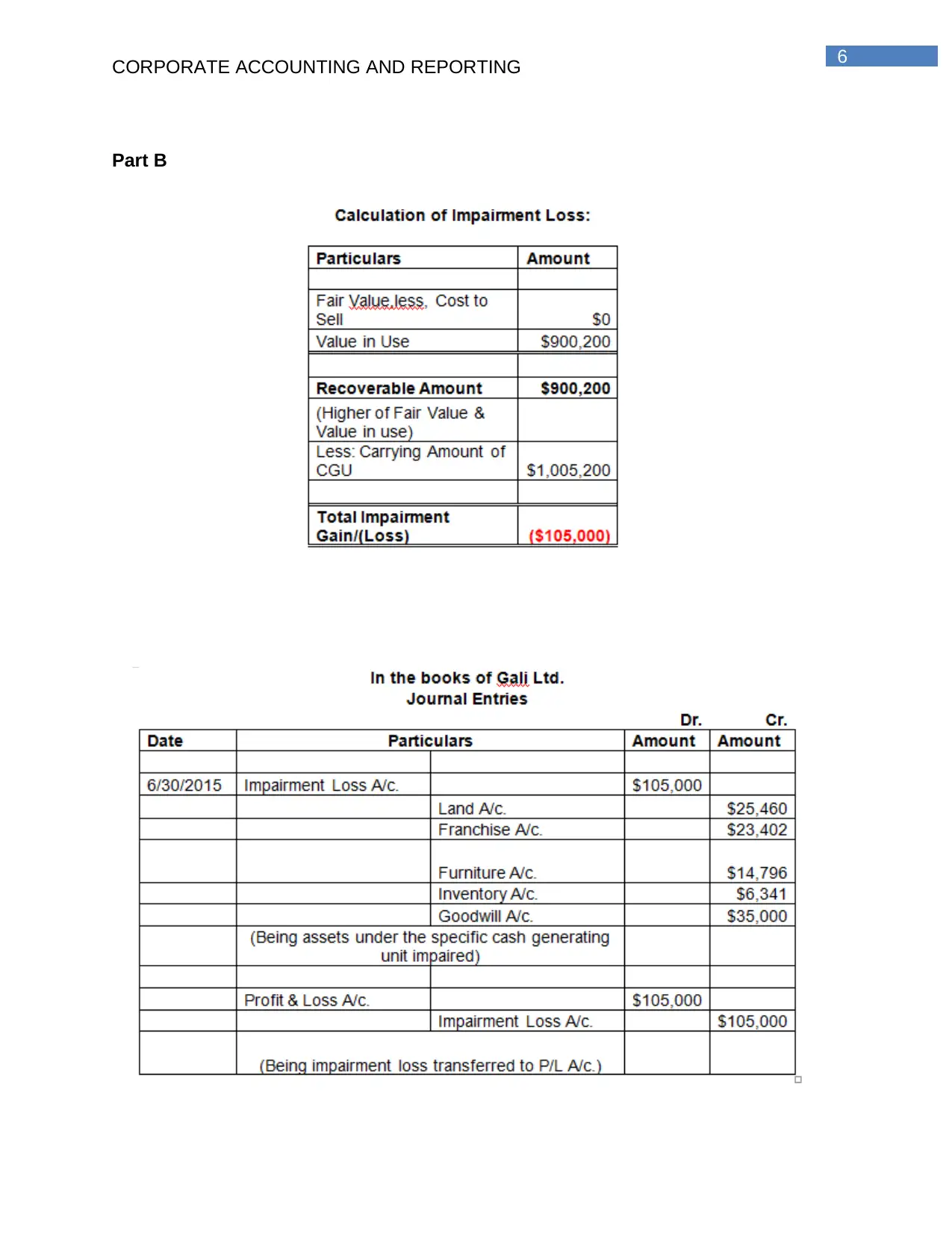
6
CORPORATE ACCOUNTING AND REPORTING
Part B
CORPORATE ACCOUNTING AND REPORTING
Part B
Paraphrase This Document
Need a fresh take? Get an instant paraphrase of this document with our AI Paraphraser
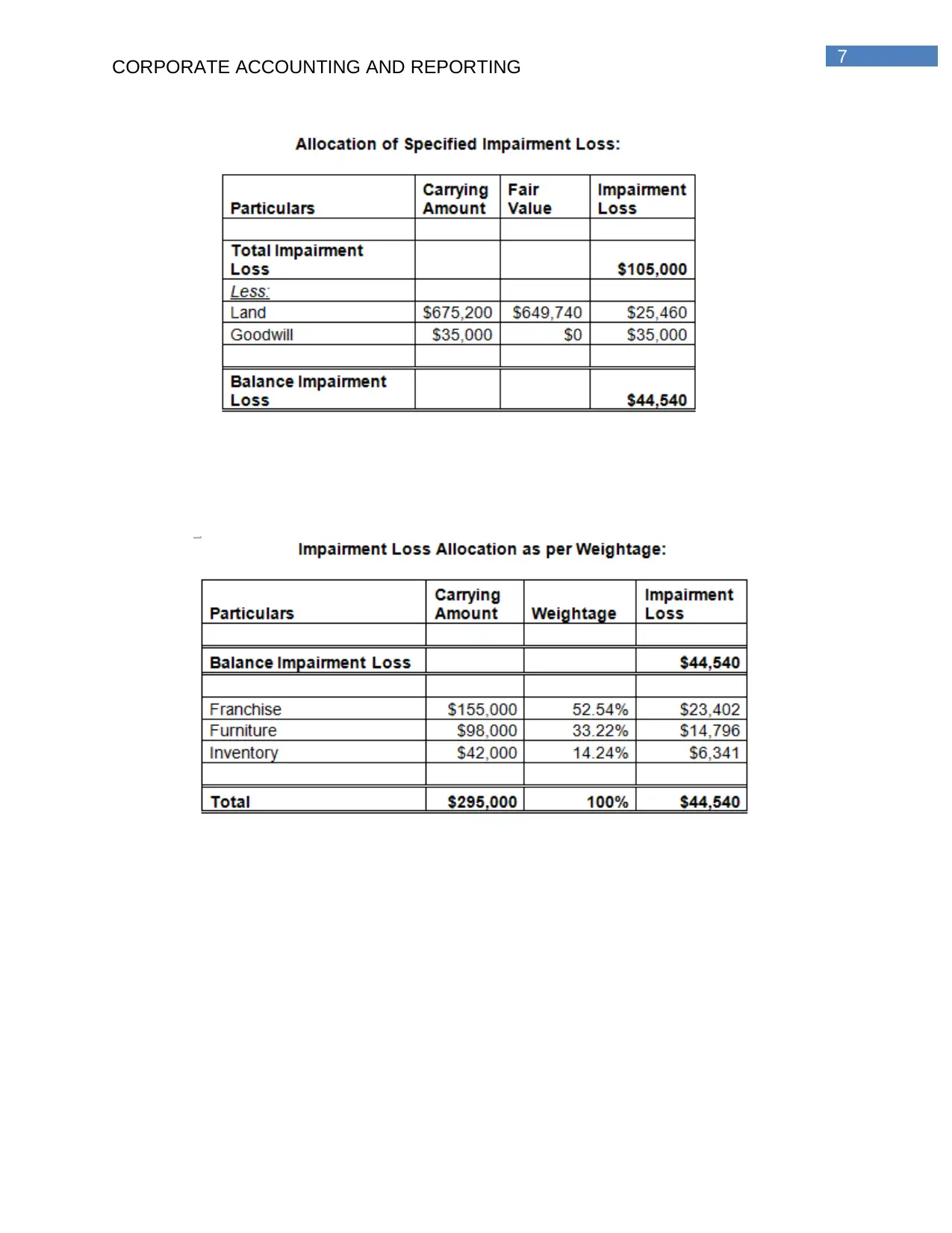
7
CORPORATE ACCOUNTING AND REPORTING
CORPORATE ACCOUNTING AND REPORTING
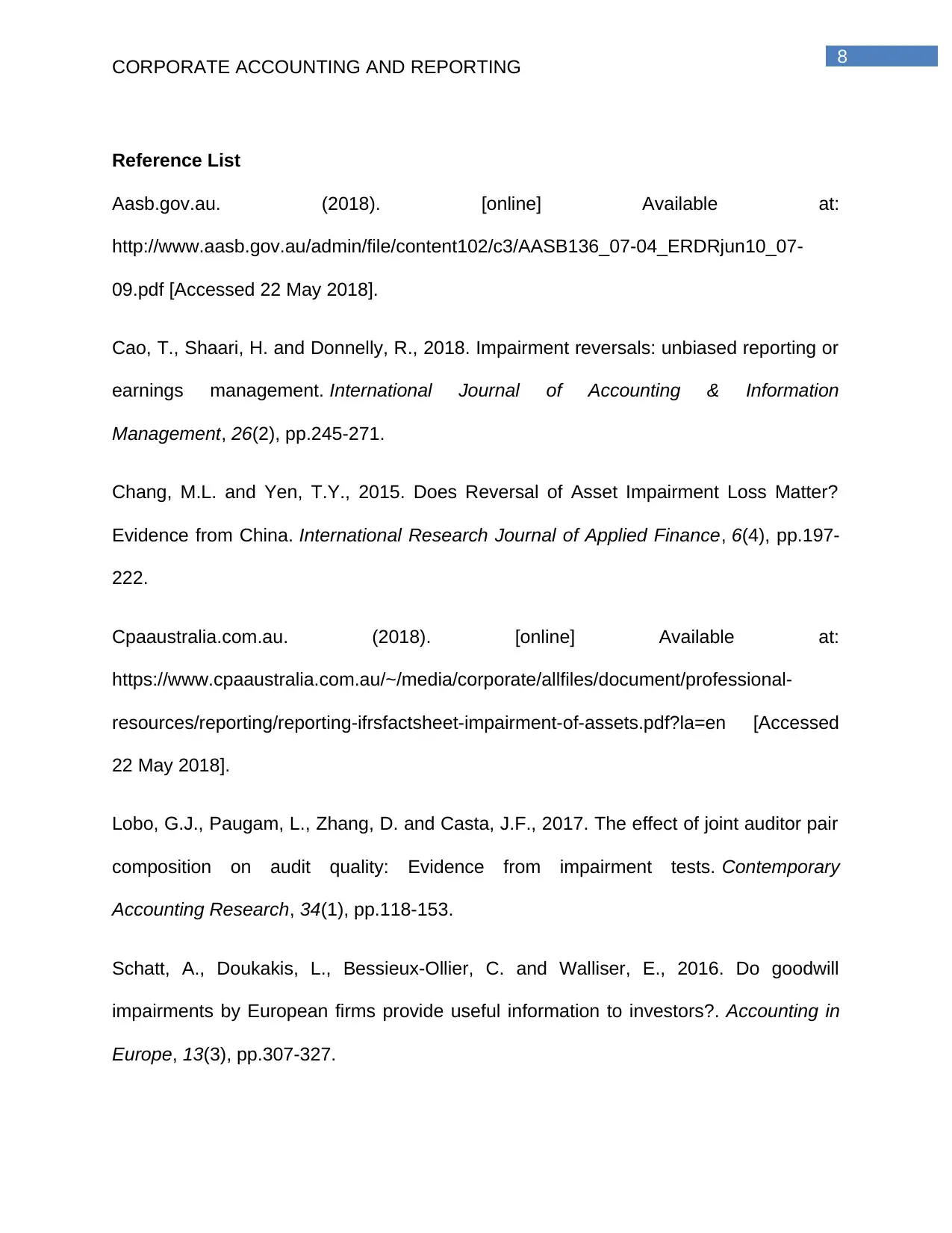
8
CORPORATE ACCOUNTING AND REPORTING
Reference List
Aasb.gov.au. (2018). [online] Available at:
http://www.aasb.gov.au/admin/file/content102/c3/AASB136_07-04_ERDRjun10_07-
09.pdf [Accessed 22 May 2018].
Cao, T., Shaari, H. and Donnelly, R., 2018. Impairment reversals: unbiased reporting or
earnings management. International Journal of Accounting & Information
Management, 26(2), pp.245-271.
Chang, M.L. and Yen, T.Y., 2015. Does Reversal of Asset Impairment Loss Matter?
Evidence from China. International Research Journal of Applied Finance, 6(4), pp.197-
222.
Cpaaustralia.com.au. (2018). [online] Available at:
https://www.cpaaustralia.com.au/~/media/corporate/allfiles/document/professional-
resources/reporting/reporting-ifrsfactsheet-impairment-of-assets.pdf?la=en [Accessed
22 May 2018].
Lobo, G.J., Paugam, L., Zhang, D. and Casta, J.F., 2017. The effect of joint auditor pair
composition on audit quality: Evidence from impairment tests. Contemporary
Accounting Research, 34(1), pp.118-153.
Schatt, A., Doukakis, L., Bessieux-Ollier, C. and Walliser, E., 2016. Do goodwill
impairments by European firms provide useful information to investors?. Accounting in
Europe, 13(3), pp.307-327.
CORPORATE ACCOUNTING AND REPORTING
Reference List
Aasb.gov.au. (2018). [online] Available at:
http://www.aasb.gov.au/admin/file/content102/c3/AASB136_07-04_ERDRjun10_07-
09.pdf [Accessed 22 May 2018].
Cao, T., Shaari, H. and Donnelly, R., 2018. Impairment reversals: unbiased reporting or
earnings management. International Journal of Accounting & Information
Management, 26(2), pp.245-271.
Chang, M.L. and Yen, T.Y., 2015. Does Reversal of Asset Impairment Loss Matter?
Evidence from China. International Research Journal of Applied Finance, 6(4), pp.197-
222.
Cpaaustralia.com.au. (2018). [online] Available at:
https://www.cpaaustralia.com.au/~/media/corporate/allfiles/document/professional-
resources/reporting/reporting-ifrsfactsheet-impairment-of-assets.pdf?la=en [Accessed
22 May 2018].
Lobo, G.J., Paugam, L., Zhang, D. and Casta, J.F., 2017. The effect of joint auditor pair
composition on audit quality: Evidence from impairment tests. Contemporary
Accounting Research, 34(1), pp.118-153.
Schatt, A., Doukakis, L., Bessieux-Ollier, C. and Walliser, E., 2016. Do goodwill
impairments by European firms provide useful information to investors?. Accounting in
Europe, 13(3), pp.307-327.
⊘ This is a preview!⊘
Do you want full access?
Subscribe today to unlock all pages.

Trusted by 1+ million students worldwide
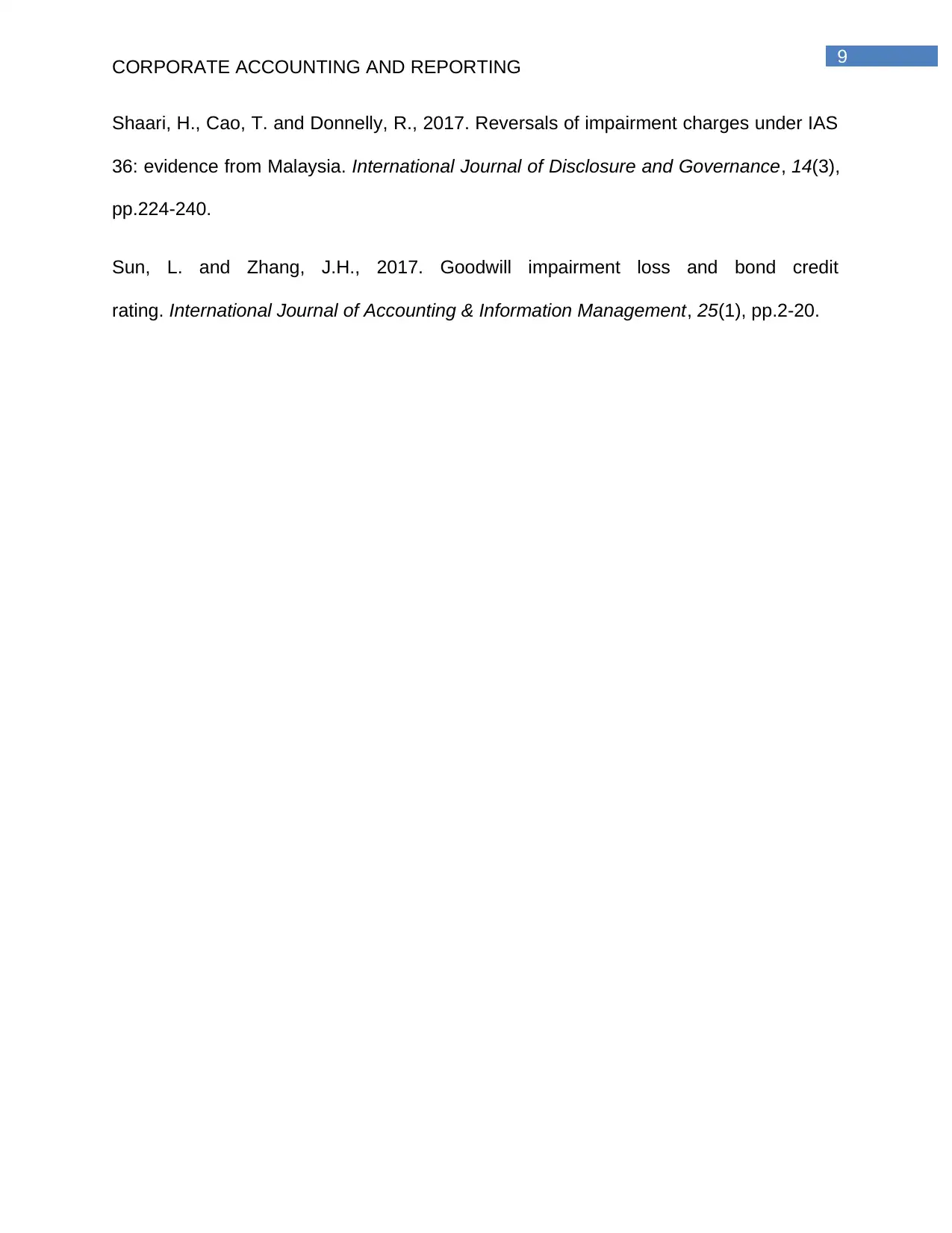
9
CORPORATE ACCOUNTING AND REPORTING
Shaari, H., Cao, T. and Donnelly, R., 2017. Reversals of impairment charges under IAS
36: evidence from Malaysia. International Journal of Disclosure and Governance, 14(3),
pp.224-240.
Sun, L. and Zhang, J.H., 2017. Goodwill impairment loss and bond credit
rating. International Journal of Accounting & Information Management, 25(1), pp.2-20.
CORPORATE ACCOUNTING AND REPORTING
Shaari, H., Cao, T. and Donnelly, R., 2017. Reversals of impairment charges under IAS
36: evidence from Malaysia. International Journal of Disclosure and Governance, 14(3),
pp.224-240.
Sun, L. and Zhang, J.H., 2017. Goodwill impairment loss and bond credit
rating. International Journal of Accounting & Information Management, 25(1), pp.2-20.
1 out of 10
Related Documents
Your All-in-One AI-Powered Toolkit for Academic Success.
+13062052269
info@desklib.com
Available 24*7 on WhatsApp / Email
![[object Object]](/_next/static/media/star-bottom.7253800d.svg)
Unlock your academic potential
Copyright © 2020–2025 A2Z Services. All Rights Reserved. Developed and managed by ZUCOL.




